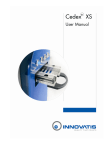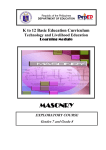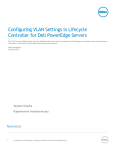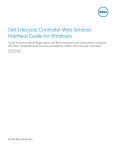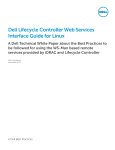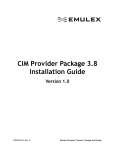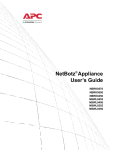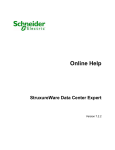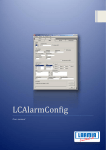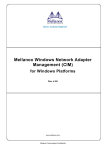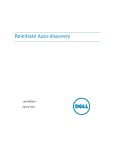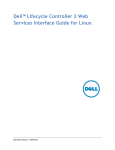Download Dell Lifecycle Controller 2 Version 1.3.0 Quick Start Manual
Transcript
Dell Lifecycle Controller 2 Remote Services Release 1.3 Quick Start Guide Notes, Cautions, and Warnings NOTE: A NOTE indicates important information that helps you make better use of your computer. CAUTION: A CAUTION indicates either potential damage to hardware or loss of data and tells you how to avoid the problem. WARNING: A WARNING indicates a potential for property damage, personal injury, or death. © 2013 Dell Inc. All Rights Reserved. Trademarks used in this text: Dell™, the Dell logo, Dell Boomi™, Dell Precision™ , OptiPlex™, Latitude™, PowerEdge™, PowerVault™, PowerConnect™, OpenManage™, EqualLogic™, Compellent™, KACE™, FlexAddress™, Force10™, Venue™ and Vostro™ are trademarks of Dell Inc. Intel®, Pentium®, Xeon®, Core® and Celeron® are registered trademarks of Intel Corporation in the U.S. and other countries. AMD® is a registered trademark and AMD Opteron™, AMD Phenom™ and AMD Sempron™ are trademarks of Advanced Micro Devices, Inc. Microsoft®, Windows®, Windows Server®, Internet Explorer®, MS-DOS®, Windows Vista® and Active Directory® are either trademarks or registered trademarks of Microsoft Corporation in the United States and/or other countries. Red Hat® and Red Hat® Enterprise Linux® are registered trademarks of Red Hat, Inc. in the United States and/or other countries. Novell® and SUSE® are registered trademarks of Novell Inc. in the United States and other countries. Oracle® is a registered trademark of Oracle Corporation and/or its affiliates. Citrix®, Xen®, XenServer® and XenMotion® are either registered trademarks or trademarks of Citrix Systems, Inc. in the United States and/or other countries. VMware®, vMotion®, vCenter®, vCenter SRM™ and vSphere® are registered trademarks or trademarks of VMware, Inc. in the United States or other countries. IBM® is a registered trademark of International Business Machines Corporation. 2013 - 12 Rev. A00 Contents 1 Introduction..................................................................................................................................5 Benefits of Using iDRAC7 with Lifecycle Controller 2.............................................................................................. 5 Key Features............................................................................................................................................................. 6 What’s New in this Release?....................................................................................................................................6 Why Use Lifecycle Controller Remote Services?..................................................................................................... 6 Licensable Features in Lifecycle Controller............................................................................................................. 7 What is the Web Service API?................................................................................................................................. 7 Where can the Lifecycle Controller API be used from?........................................................................................... 7 Who can use the API?.............................................................................................................................................. 8 How is One-to-Many Management Achieved?........................................................................................................ 9 Other Documents You May Need............................................................................................................................. 9 Accessing Documents From Dell Support Site.........................................................................................................9 Contacting Dell....................................................................................................................................................... 10 2 Remote Services Features.......................................................................................................11 Deployment and Configuration............................................................................................................................... 11 BIOS Configuration...........................................................................................................................................11 iDRAC Configuration.........................................................................................................................................11 RAID Configuration...........................................................................................................................................11 NIC Configuration.............................................................................................................................................12 Operating System Deployment.........................................................................................................................12 System Configuration XML...............................................................................................................................13 Monitor................................................................................................................................................................... 13 Hardware Inventory......................................................................................................................................... 13 Lifecycle Log.................................................................................................................................................... 13 System Event Log............................................................................................................................................. 14 Firmware Inventory.......................................................................................................................................... 14 Event Alerts...................................................................................................................................................... 14 Maintain..................................................................................................................................................................14 Firmware Update..............................................................................................................................................14 Part Replacement.............................................................................................................................................15 System Configuration XML - Export or Import................................................................................................. 15 Server Profile - Export or Import...................................................................................................................... 15 Server License–Import.....................................................................................................................................15 Auto-Discovery.................................................................................................................................................15 Job Management....................................................................................................................................................16 Job Types......................................................................................................................................................... 16 System Status...................................................................................................................................................16 3 Getting Started with API Collateral and Links...................................................................... 19 Profiles....................................................................................................................................................................19 CMC for PowerEdge VRTX Profiles..................................................................................................................19 Lifecycle Controller-related Profiles................................................................................................................ 20 MOF WSDL and XSD API Definitions......................................................................................................................24 Managed Object File........................................................................................................................................ 24 Web Service Description Language (WSDL)................................................................................................... 24 XML Schema Description.................................................................................................................................24 Web Services Interface Guide............................................................................................................................... 24 Best Practices Guide.............................................................................................................................................. 25 Attribute Registry XML............................................................................................................................................25 Event Message Registry XML.................................................................................................................................25 XML Schemas.........................................................................................................................................................25 Authorization and Licensing Requirements for API Access...................................................................................26 White Papers.......................................................................................................................................................... 26 CMC for PowerEdge VRTX White Papers........................................................................................................ 27 CMC PowerEdge M1000e White Papers..........................................................................................................27 Lifecycle Controller and iDRAC White Papers................................................................................................. 27 4 Integrating the Lifecycle Controller API................................................................................29 API Clients.............................................................................................................................................................. 29 Best Practices Workflow References.................................................................................................................... 29 Sample Scripts and Tools....................................................................................................................................... 29 Applications Using Lifecycle Controller-Remote Services.....................................................................................30 WinRM and OpenWSMAN Installation and Configuration.....................................................................................30 5 Social Media Reference.......................................................................................................... 31 Systems Management Forum Section....................................................................................................................31 Lifecycle Controller Technical Learning Series..................................................................................................... 31 6 Terms and Definitions...............................................................................................................33 Introduction 1 The Dell Lifecycle Controller provides advanced embedded systems management. It includes a 1GB–managed and persistent storage that embeds systems management features in addition to the iDRAC features. The Dell Lifecycle Controller Remote Services further enables remote systems management in a one-to-many method. Remote Services is accessible over the network using the secure Web services interface and can be programmatically utilized by applications and scripts. Remote services enable management consoles to perform one-to-many bare-metal server provisioning. The combination of the Auto-discovery feature to identify and authenticate the attached Dell system to the network and integration with one‑to-many management consoles reduces the manual steps required for server setup and management. The interface is aimed at simplifying many tasks, some of which include remotely deploying an operating system, remote update and inventory, and remotely automating the setup and configuration of new and already-deployed Dell systems. Lifecycle Controller reduces the time and number of steps taken to accomplish tasks, reduces potential for error, enhances server and application uptime and security, and results in more efficient IT management. Developed on the industry standard Unified Extensible Firmware Interface (UEFI) platform and Web Services for Management (WSMAN) interfaces, Lifecycle Controller provides an open environment for console integration that also allows custom scripting for Lifecycle Controller. Leading systems management consoles such as, Microsoft System Center Configuration Manager, BMC Software BladeLogic Operations Manager, Symantec Deployment Solution, and Dell Management Console have integrated Dell Lifecycle Controller to utilize its features and capabilities to an existing infrastructure, where these consoles are installed. Benefits of Using iDRAC7 with Lifecycle Controller 2 At the heart of 12th generation server’s embedded management is iDRAC7 with Lifecycle Controller technology, that allows you to perform useful tasks such as configuring BIOS and hardware settings, deploying operating systems, updating drivers, changing RAID settings, and saving hardware profiles. Together, iDRAC7 and Lifecycle Controller provide a robust set of management functions that can be used throughout the entire server lifecycle. Dell Lifecycle Controller simplifies server lifecycle management— from provisioning, deployment, patching and updating to servicing and user customization—both locally and remotely. Lifecycle Controller includes managed and persistent storage that embeds systems management features and Operating System device drivers directly on the server. This eliminates the media-based system management tools and utilities traditionally needed for systems management. The benefits include: • Increased Uptime — Early notification of potential or actual failures that help prevent a server failure or reduce recovery time after a failure. • Improved Productivity and Lower Total Cost of Ownership (TCO) — Extending the reach of administrators to larger numbers of distant servers can make IT staff more productive while driving down operational costs such as travel. • Secure Environment — By providing secure access to remote servers, administrators can perform critical management functions while maintaining server and network security. • Enhanced Embedded Management using Lifecycle Controller – By providing simplified deployment and serviceability through the Lifecycle Controller GUI for local deployment and Remote Services (WS–Management) interfaces for remote deployment integrated with Dell OpenManage Essentials and partner consoles. 5 For more information about iDRAC7, see the Integrated Dell Remote Access Controller User’s Guide available at dell.com/support/manuals Key Features You can perform the following systems management tasks using Lifecycle Controller-Remote services: • Install operating systems and drivers • Manage Licensing • Perform BIOS firmware updates • Part Replacement and automatic restore of server configuration • Perform component firmware updates • Get hardware inventory information • Get and set NIC/CNA and RAID configuration • Get and set BIOS configuration and BIOS passwords • Full export lifecycle log and add work notes • Export current- and factory-shipped hardware inventory log • Manage, attach, and boot to vFlash SD card partitions • Lock the controllers using the local key • Export and import the server profile • Import server license • View firmware details during server update • Export and import System Configuration XML • Schedule and track the status of the update and configuration • Import and export System Configuration XML file that contains information about a component configuration • Backplane and enclosure firmware update • Faster iDRAC firmware update • Shutdown job type • Support for Fibre Channel (FC) HBA cards What’s New in this Release? The highlights of this release of Lifecycle Controller-Remote Services are: • Part Replacement and automatic restore of server configuration • Import server license • View firmware details during server update • Full export lifecycle log • General support for PERC9 Why Use Lifecycle Controller Remote Services? When Dell examined the most common management tasks and the inefficiencies associated with them, it discovered that the additional time taken for performing management tasks was not because of the tools, but it was because of how the functions were split between several tools. For example, the most common tasks such as provisioning, deploying, and updating required not only multiple tools and multiple media format, but also searching the Web for tools such as 6 drivers and firmware. This traditional delivery model resulted in inefficient use of time, potential errors, and possible security risks. Lifecycle Controller-Remote Services addresses all these system management issues. Licensable Features in Lifecycle Controller The Web Services for Management (WSMAN) License and Privilege Specification encompasses all the license and privilege information required to utilize the WSMAN API provided by the integrated Dell Remote Access Controller (iDRAC7) with Lifecycle Controller 2.0. It was delivered as a part of the integrated Dell Remote Access Controller or iDRAC (Express and Enterprise licenses, and vFlash SD card feature) starting with Dell PowerEdge 11th generation servers. On 12th generation servers, the vFlash feature is included with the iDRAC7 Enterprise License, so that you need not separately license vFlash with Lifecycle Controller 2.0 and later. The 12th generation servers of Dell use only Express or Enterprise licensing. The Lifecycle Controller management capabilities are partitioned into distinct areas and represented by the Dell Common Information Model (DCIM) profile specifications that provide comprehensive details about each manageability feature or capability. These features may be free, partially licensed, or fully licensed. Also, the accessibility of a feature is defined by the credentials provided with the WSMAN request and maps to the user-assigned privilege credentials, such as administrator- or read-only access. What is the Web Service API? Web Services-Management (WSMAN) is a Distributed Management Task Force (DMTF) open standard, defining a Simple Object Access Protocol (SOAP)—based protocol for managing servers, devices, applications, and various Web services. WSMAN provides a common way for systems to access and exchange management information across the IT infrastructure. DMTF is an industry organization that develops, maintains, and promotes standards for systems management in enterprise IT environments. The DMTF data model is complex and typically requires multiple transactions to accomplish simple operations such as specifying a user name and password, or giving administrator privileges to a user account. To reduce the number of transactions, Lifecycle Controller also offers a Dell data model for management that is based on an attribute model. Where can the Lifecycle Controller API be used from? Lifecycle Controller-Remote Services is a standards-based interface that enables consoles to integrate, for example, bare-metal provisioning and one-to-many operating system deployments for remotely located servers. Dell’s Lifecycle Controller takes advantage of the capabilities of both Lifecycle Controller GUI and Lifecycle Controller-Remote Services 7 to deliver significant improvement and simplification of server deployment. Lifecycle controller also supports local one-to-one system management tasks through a graphical user interface (GUI) using the server’s KVM or the Virtual Console in iDRAC for operating system installation, updates, configuration, and for running diagnostics on single and local servers. This eliminates the need for multiple option ROMs for hardware configuration. For more information, see Lifecycle Controller User’s Guide, available at delltechcenter/lc. Who can use the API? Lifecycle Controller-Remote Services features are available based on the type of license (that is, Basic Management, iDRAC7 Express, iDRAC7 Express for Blades, or iDRAC7 Enterprise) you purchase. Only licensed features are available in the iDRAC7 Web interface and Lifecycle Controller-Remote Services. For more information about managing licenses, see iDRAC7 User’s Guide. For more information about Lifecycle Controller-Remote Services licensing, see Licensing. NOTE: Special characters can be used in username and password. However, they must be percent-encoded. For example, @ should be entered as %40. 8 How is One-to-Many Management Achieved? A management station sends WSMAN commands over a network and the WSMAN commands pass securely through the network from outside the firewall and maintain security. Other Documents You May Need Along with this Quick Start Guide, you can access the following guides. • The Lifecycle Controller Online Help provides information about using the Lifecycle Controller through the graphical user interface (GUI). To access the Online Help, click Help in the upper-right corner of Lifecycle Controller GUI or press <F1>. • The Dell Lifecycle Controller 2 GUI User's Guide provides information about using the Lifecycle Controller features that you can perform using the GUI. • The WS-MAN Profile Documents available at Dell TechCenter delltechcenter/lc. • The Lifecycle Controller 2 Release Notes provides last-minute updates to the system or documentation or advanced technical reference material intended for experienced users or technicians delltechcenter/lc. Accessing Documents From Dell Support Site To access the documents from Dell Support site: 1. Go to dell.com/support/manuals. 2. In the Tell us about your Dell system section, under No, select Choose from a list of all Dell products and click Continue. 3. In the Select your product type section, click Software and Security. 4. In the Choose your Dell Software section, click the required link from the following: – Client System Management – Enterprise System Management – Remote Enterprise System Management – Serviceability Tools 9 5. To view the document, click the required product version. NOTE: You can also directly access the documents using the following links: • For Enterprise System Management documents — dell.com/openmanagemanuals • For Remote Enterprise System Management documents — dell.com/esmmanuals • For Serviceability Tools documents — dell.com/serviceabilitytools • For Client System Management documents — dell.com/OMConnectionsClient • For OpenManage Connections Enterprise systems management documents — dell.com/ OMConnectionsEnterpriseSystemsManagement • For OpenManage Connections Client systems management documents — dell.com/OMConnectionsClient Contacting Dell NOTE: If you do not have an active Internet connection, you can find contact information on your purchase invoice, packing slip, bill, or Dell product catalog. Dell provides several online and telephone-based support and service options. Availability varies by country and product, and some services may not be available in your area. To contact Dell for sales, technical support, or customer service issues: 1. Visit dell.com/support 2. Select your support category. 3. Verify your country or region in the Choose a Country/Region drop-down menu at the top of page. 4. Select the appropriate service or support link based on your need. 10 Remote Services Features 2 Using Lifecycle Controller-Remote Services, you can perform the following operations: • Deploy and Configure • Monitor • Maintain • Create and schedule jobs Deployment and Configuration Using various Lifecycle Controller-Remote Services' capabilities, you can perform different configurations on a system throughout its lifecycle. You can perform operations such as BIOS, iDRAC, RAID, and NIC configurations, and operating system deployment on the system. BIOS Configuration The BIOS and boot configuration feature gets and sets any of the configurable BIOS attributes that are exposed in BIOS UEFI HII. You can perform the following operations: • Retrieve current configuration of BIOS inventory • Retrieve current boot configuration settings • Manage the boot order configuration • Change the BIOS boot mode or UEFI boot mode • Manage BIOS Passwords • Change the boot order • Enable or disable boot sources iDRAC Configuration The iDRAC configuration feature is used to manage the properties and interfaces for running system management tasks related to the management of basic properties of iDRAC. The remote access controller properties and attributes are divided into views to provide a simple methodology for the clients to query the iDRAC views and set the iDRAC attributes. You can perform the following operations: • Retrieve current card configuration and iDRAC inventory • Get and set any configurable iDRAC attribute • Manage iDRAC local user accounts RAID Configuration The RAID configuration feature is used to manage the properties and capabilities of the RAID storage. The RAID storage is modeled using a collection of attributes, where there are collections for the enclosures, storage adaptors, logical 11 disks, physical disk drives, and parent-child relationships between the collections. Additionally, there is a configuration service that contains all the methods used to configure the RAID storage. You can perform the following operations: • Retrieve current configuration of RAID inventory • Delete all virtual disks and unassign all the hot spare physical disk drives • Prepare any foreign physical disk drives for inclusion in the local configuration • Manage hot spares • Manage Keys for self-encrypting drives • Manage virtual disks • Set controller attributes • Change RAID-ready states of the physical disk drives NIC Configuration Network Interface Controller (NIC) configuration feature is used to set up or modify configuration settings for supported NIC cards (for example, Intel, Qlogic, and Broadcom). These configuration settings can be set or updated both locally and remotely using Lifecycle Controller-Remote Services. The NICs supported by Lifecycle Controller provide an array of networking features converged into a single controller: • Traditional NIC capabilities • Internet Small Computer System Interface over Ethernet (iSCSI) capabilities • Fibre Channel over Ethernet (FCoE) capabilities You can configure various device capabilities such as: • Personalities (FCoE, ISOE, Layer 2 NIC) • NIC partition bandwidth allocation • Boot versus Offload • I/O Identity Operating System Deployment The operating system deployment feature is used to remotely deploy and manage an operating system using WSMAN Web services protocols that use CIFS and NFS network file sharing protocols. Remote activation of locally exposed embedded drivers such as a USB drive eliminates the need for physical media. You can perform the following operations: • Get installed Driver Pack version and list of supported operating systems. • Remote activation of locally exposed embedded drivers for the selected operating system as an emulated USB device to the server that is automatically installed during installation. • Remote acquisition of embedded drivers for the selected operating system to a CIFS or NFS network share that can be used later for operating system deployment. • Boot to an ISO image located on a CIFS or and NFS network share to initiate an operating system installation. • Download ISO to vFlash SD card and boot from the card to initiate an operating system installation. • Connecting an ISO from CIFS or NFS network share, attaching it as virtual USB CD-ROM device to the server, and booting the server to the ISO, every time the server restarts. • One time boot to PXE. • One time boot to hard disk. 12 • Get the list of MAC Addresses of all the NICs present on the server. • Deploying Operating System on iSCSI and FCOE LUN. System Configuration XML A system configuration XML file containing the component configuration information is used to apply the configuration for BIOS, iDRAC, RAID, and NIC by importing the file to a target system. For more information, see XML Configuration Workflow white paper. Monitor Using various Lifecycle Controller-Remote Services capabilities, you can monitor a system throughout its lifecycle. Current and factory-shipped hardware inventory, Lifecycle Log, System Event Log, Firmware Inventory are some of the features that help you monitor the system. Hardware Inventory The hardware inventory information is cached on the persistent storage of Lifecycle Controller and is available to iDRAC and UEFI applications. It is used to export the hardware inventory from Lifecycle Controller to a text file on a remote share. You can remotely query the inventory of hardware components. Each hardware inventory classes contains important attributes about the hardware components. For example, the LastSystemInventoryTime attribute identifies when the last time a Collect System Inventory on Restart (CSIOR) was run. It is an important attribute as it indicates how recently the inventory was updated. Hardware inventory and configuration information is available for the following components: • Power Supply Unit • Fan • Memory • CPU • iDRAC • PCI Device • Video Card • vFlash SD Card • NIC • RAID • BIOS • System • Sensor Lifecycle Log Lifecycle logs contain entries for configuration and firmware updates of BIOS, Storage Controllers, LOMs, and add-in NIC cards, if supported. The Lifecycle Log can be exported to a network share or saved to a USB drive. The lifecycle log is accessible through the iDRAC7 Web interface, RACADM, and WSMAN interface. The full Lifecycle log provides the following information: • iDRAC, BIOS, NIC, and RAID configuration changes 13 • Logs of all the remote operations • Firmware update history on the basis of device, version, and date • Error message IDs. For more information about Event and Error Messages, see the Dell Event Message Reference Guide available at dell.com/support/manuals. System Event Log The Lifecycle log contains events related to system, storage devices, network devices, firmware updates, configuration changes, license messages, and so on. However, the system events are also available as a separate log called the System Event Log (SEL). When a system event occurs on a managed system, it is recorded in the SEL. The same SEL entries is also available in the Lifecycle Log. Firmware Inventory Lifecycle Controller-Remote Services provides information about each of the component firmware installed on the target system and the available firmware images are cached in the Lifecycle Controller. Additional information contained in the available properties are: • Firmware type • Firmware version • Installation date • Vendor IDs • Revision number Event Alerts Alerts and actions can be set for certain events that occur on a managed system. An event occurs when the status of a system component has changed with respect to the pre-defined condition. If an event matches an event filter and this filter is configured to generate an alert (e-mail, SNMP trap, or IPMI alert), an alert is sent to one or more configured destinations. If the same event filter is also configured to perform an action (such as reboot, power cycle, or power off the system), the action is performed. You can set only one action for an event. Maintain Using various Lifecycle Controller-Remote Services capabilities, you can maintain the health of a system throughout its lifecycle. You can use features such as remote firmware management, part replacement, server profile import or export, and auto-discovery to maintain a system using Lifecycle Controller-Remote Services. Firmware Update You can perform firmware updates from a network source to either update or rollback component firmware. A rollback operation is used to install the previous version of a component firmware. The firmware update operations or firmware rollback operations are performed in the following order: 1. Initiate and download an image. 2. Create a reboot job. 14 3. Schedule an update job. 4. Monitor a job until the job is finished. NOTE: There are some components for which the updates are immediately applied after the firmware is downloaded, after which the system automatically restarts. Part Replacement The Part Replacement feature is used to automatically update a firmware, configuration, or both for a newly-replaced component, such as a RAID controller, NIC, or power supply, to match with the original part. It is a licensed feature that is disabled by default, and can be enabled if required. When a component is replaced and the part replacement feature is enabled, the actions performed by Lifecycle Controller is locally displayed on the system monitor during POST. You can remotely configure part replacement-related properties through the Web services interface using the WSMAN protocol. When a motherboard is replaced, the system configuration is automatically restored. However, if the service tag of a system is deleted for any reason, then you can manually enter the service tag. System Configuration XML - Export or Import Lifecycle Controller-Remote Services can export or import a System Configuration XML file. The export operation collects the configuration information for BIOS, iDRAC, RAID, NIC, FC-HBA, system, and Lifecycle Controller and stores it in a single file that is copied to a network share. The Import operation imports the file from a network share, and applies the previously-saved or updated configurations to a system. For more information, see the XML Configuration Workflow white paper available at Dell TechCenter. Server Profile - Export or Import Lifecycle Controller-Remote Services can export (backup) or import (restore) the server profile of the host system. These operations are commonly used during motherboard replacement. The export feature gathers system information, firmware images, hardware configuration, Lifecycle Controller configuration, iDRAC firmware and configuration, and stores the information to a single file located on the local vFlash SD card or a remote network share. The import feature applies the saved configurations to a system from the local vFlash SD card, or from a network share. Server License–Import Lifecycle Controller-Remote Services can import (restore) the server license of a host system. These operations are commonly used during motherboard replacement. You can import the license that is stored on a USB drive or on the network share such as CIFS or NFS. Auto-Discovery The Auto-Discovery feature in iDRAC allows newly-installed servers to automatically discover the remote management console that hosts the Provisioning Server. The Provisioning Server provides custom administrative user credentials to iDRAC so that the management console can discover and manage the newly-installed managed system. If you ordered a Dell system with the Auto-Discovery feature Enabled (factory default setting is Disabled), then iDRAC is delivered with DHCP enabled and user accounts disabled. If the Auto-discovery feature is disabled, you can manually enable this feature and disable the default administrative account using the iDRAC7 Settings utility. For more information about the iDRAC Settings utility, see iDRAC7 User’s Guide. 15 For more information about Auto-discovery, see the Lifecycle Controller Management profile document available at Dell TechCenter. Job Management The Lifecycle controller has the capability to create, schedule, track, and manage system management tasks that are referred to as “jobs”. A single job or array of jobs can be run immediately or scheduled to run at a later time. Multiple jobs are listed in the order of job execution sequence. If a system must reboot at the scheduled start time, a reboot job needs to be added to the job list. Remote Services provides the following functions to manage Lifecycle Controller jobs: • Creating Jobs — Create specific types of jobs to apply configurations. • Scheduling Jobs and Job Queues — Run multiple jobs in a single restart of the system using the SetupJobQueue() method. If a job is created without setting the start time, use the SetupJobQueue() method to set the schedule and order of execution. The job is set up for execution at the time that was specified. • Deleting Jobs — Delete a specified existing job or all jobs at once. • Reporting all Jobs — Report all jobs using a single command. • Reporting scheduled Jobs — Generate a report of all scheduled jobs using a selection filter of JobStatus = Scheduled. Job Types There are two types of jobs, system-created jobs (implicit) and user-created jobs (explicit): • System-created jobs are created when you run specific Remote Services tasks. For example, Remote Services features such as export hardware inventory, export license, create persistent storage partition, and so on create a job and return the job ID. Polling the job status determines the completion status of the task. • User-created jobs such as CreateTargetedConfigJob, CreateRebootJob, and InstallFromURI are used to apply user configurations for RAID, NIC, BIOS, and so on. They can be scheduled to run immediately or at a scheduled time. Table 1. System and User Created Jobs System-created Jobs User-created Jobs • • • • • • • • • • • • • • • • • Export Factory Configuration Export Hardware Inventory Export Lifecycle log vFlash (Initialize) vFlash (Create Partition) vFlash (Format Partition) vFlash (Attach Partition) vFlash (Detach Partition) vFlash (Export Data from Partition) vFlash (Create Partition using Image) RAID configuration BIOS configuration NIC configuration iDRAC configuration System configuration Software update (BIOS, NIC, RAID, and so on) Reboot System Status This feature is used to remotely obtain the overall Remote Services API status that includes both the host system status and as well as the remote services (Data Manager) status. The overall status is displayed in the Status output parameter. 16 After the job is complete in Automated Task Application (previously SSM), the job status is immediately updated in the job store. The job is immediately moved to the Completed state after it is complete in the Automated Task Application. After the job is completed, synchronization occurs in the configDB and refreshes all the required populators. When this operation is successful, the system is in the Ready state. 17 18 Getting Started with API Collateral and Links 3 Getting started with any feature of Lifecycle Controller begins at the Dell Tech Center Lifecycle Controller home page — delltechcenter.com/LC. The home page contains various sections that reference URLs, and these referenced URLs are direct links to the corresponding sections. You can follow these steps to get started using the Lifecycle Controller API: 1. Identify the feature or the required management operation. 2. Determine how the API is constructed for the desired management activity. 3. Utilize a client to access the API. 4. Use the best practices work flows for the client to interact with the API to accomplish the activity. Profiles Profiles describe the behavior of each feature and necessary classes, properties, methods, and configurable management attributes that represent the feature. They explain “what” is supported by Lifecycle Controller-Remote Services provided within the context of the CIM architecture. Profile specifications are organized around different management areas or domains. CMC for PowerEdge VRTX Profiles NOTE: To view the profile documents, on the Dell TechCenter (delltechcenter.com/LC) page, under Reference Specifications, click Profiles. Alternatively, go to en.community.dell.com/techcenter/systems-management/w/wiki/ 1906.aspx Table 2. Profiles Profile Name Description DCIM Chassis Event Filter Profile The Event Filter Profile describes the properties and methods of the Event Filter in the managed system element or component. This profile describes the association between the managed system element and 102 the event filters and the individual event filters. For more information about the DCIM Chassis Event Filter Profile, go to http://en.community.dell.com/TECHCENTER/ EXTRAS/M/WHITE_PAPERS/20399987.ASPX DCIM Chassis Job Control Profile The Dell Chassis Job Control Profile extends the management capabilities of referencing profiles by adding the capability to create, schedule, track, and manage jobs that represent platform management operations. For more information about the DCIM Chassis Job Control Profile, go to http://en.community.dell.com/techcenter/extras/m/white_papers/20399991.aspx. DCIM Chassis The Chassis License Management Profile is an autonomous profile for modeling the Dell License Management Product License Manager (License Manager). It extends the management capabilities of Profile referencing profiles by adding the capability to represent the devices and Licenses managed by the Dell Product Licensing Manager. For more information about the DCIM Chassis License 19 Profile Name Description Management Profile, go to http://en.community.dell.com/TECHCENTER/EXTRAS/M/ WHITE_PAPERS/20399993.ASPX. DCIM PCI Management Profile The Dell Chassis PCI Management Profile describes the properties and interfaces for executing system management tasks related to the management of the PCI slots and adapters in a modular system. The profile standardizes and aggregates the description for the PCI adapter’s basic properties into a PCI device view representation, the PCI slot basic properties into a slot and provides a methodology for the clients to query these representations without substantial traversal of the model. For more information about the DCIM PCI Management Profile, go to http://en.community.dell.com/TECHCENTER/EXTRAS/M/WHITE_PAPERS/ 20399998.ASPX. DCIM Chassis RAID Profile The Chassis RAID Profile extends the management capabilities of referencing profiles by adding the capability to represent the configuration of RAID storage. The RAID storage is modeled as collections of attributes where there are collections for the end enclosures, storage adaptors, logical disks, physical disk drives, and parent-child relationships between the collections. For more information about the DCIM Chassis RAID Profile, go to http:// en.community.dell.com/TECHCENTER/EXTRAS/M/WHITE_PAPERS/20399999.ASPX. DCIM Chassis Record The DCIM Chassis Record Log Profile provides the management capabilities to represent logs Log Profile for the modular chassis. This profile provides information on managing various logs: chassis log, CMC event log and CMC software (RAC event log). For more information about the DCIM Chassis Record Log Profile, go to http://en.community.dell.com/TECHCENTER/EXTRAS/M/ WHITE_PAPERS/20400001.ASPX. DCIM Chassis Software Inventory Profile The Dell Software Inventory Profile extends the management capabilities of referencing profiles by adding the capability to represent the software inventory of system. For more information about the DCIM Chassis Software Inventory Profile, go to http:// en.community.dell.com/TECHCENTER/EXTRAS/M/WHITE_PAPERS/20400004.ASPX. DCIM Chassis System Info Profile Chassis System Info Profile Profile describes the properties and interfaces for executing system management tasks related to the management of a modular chassis that contain blade servers. The profile standardizes and aggregates the description for the platform’s basic properties into a system view representation and provides a methodology for the clients to query the system views without substantial traversal of the model. For more information about the DCIM Chassis System Info Profile, go to http://en.community.dell.com/TECHCENTER/ EXTRAS/M/WHITE_PAPERS/20400006.ASPX. DCIM CMC Profile The DCIM CMC Profile describes the properties and interfaces for executing system management tasks related to the management of basic properties of CMC. The profile standardizes and aggregates the description of CMC properties into a CMC attribute representation, and provides static methodology for the clients to set the CMC attributes without substantial traversal of the model. For more information about the DCIM CMC Profile, go to http://en.community.dell.com/TECHCENTER/EXTRAS/M/WHITE_PAPERS/20400007.ASPX. Lifecycle Controller-related Profiles NOTE: To view the profile documents, on the Dell TechCenter (delltechcenter.com/LC) page, under Reference Specifications, click Profiles. Alternatively, go to en.community.dell.com/techcenter/systems-management/w/wiki/ 1906.aspx 20 Table 3. Profiles Profile Name Description Active Directory The Active Directory Client Profile extends the management capabilities of referencing profiles by adding the capability to represent the configuration of Active Directory client service and the groups managed by the service. Base Metrics The DMTF Common Interface Model (DCIM) Base Metrics Profile extends the DMTF Base Metrics Profile to add Dell-specific implementation requirements for power-related metrics. The profile standardizes the units and description for the metrics, and provides static methodology for the clients to query the metrics without substantial traversal of the model. Base Server and Physical Asset The Base Server Profile is the autonomous profile that defines the classes used to describe basic server hardware and its related software. BIOS and Boot Management The BIOS and Boot Management Profile extends the management capabilities of referencing profiles by adding the capability to represent the configuration of the system BIOS setup and to manage the boot of the system. CPU The DCIM CPU Profile describes the properties and interfaces for executing system management tasks related to the management of processors within a system. Ethernet Port The Ethernet Port Profile extends the management capability of referencing profiles by adding the ability to represent an Ethernet port, its associated controller, and Ethernet interfaces. Event Filter The Dell Event Filter Profile provides the management capabilities to view the event filters and set actions and notifications for the events. Fan The DCIM Fan Profile describes the properties and interfaces for executing system management tasks related to the management of fans within a system. Fiber Channel The Fiber Channel Profile extends the management capabilities of referencing profiles by adding the capability to represent the configuration of fiber channel host bus adapters (FC HBA). iDRAC Card The DCIM iDRAC Card Profile describes the properties and interfaces for performing system management tasks related to the management of basic properties of iDRAC card. DCIM_iDRACCardEnumeration class has attributes PTMode and AdminState to support configuration of iDRAC Network Bridge in LOM-P2P or USB-P2P modes. VNC server configuration is possible by setting attributes of Port, Timeout, Password, Enable and LowerEncryptionBitLength. DCIM_iDRACCardInteger has new attribute SMTPPort for SMTP configuration and AlertPort and DiscoveryPort for SNMP configuration. DCIM_iDRACCardEnumeration class has attributes PTMode and AdminState to support configuration of iDRAC Network Bridge in LOM-P2P or USB-P2P modes. Basic OMSA Equivalency: Some features (such as WatchdogResetTime andLCLReplication) currently provided by OMSA will be available on iDRAC service module (iSM). Job Control The Job Control Profile extends the management capabilities of referencing profiles by adding the capability to create, schedule, track, and manage jobs that represent platform management operations. LC Management The Lifecycle Controller (LC) Management Profile describes the management of the Dell Lifecycle Controller and its configuration attributes. The ExportCertificate() method is used to export unique generated SSL Certificates from the Lifecycle Controller to a file in remote share location. 21 Profile Name Description The DCIM_LCService. ExportHealthReport() method is used to collect the EHR. That is, hardware, operating system and application data, compress the zip file, and then to save in to the respective remote share path (cifs/nfs ). The DCIM_LCService.ImportSystemConfigurationPreview() method is used to preview the results of the application of the XML template ahead of the actual application without any restart. It also gives the information about the failure. The successful invocation of this method returns a job. The methods DCIM_SoftwareInstallationService:SetUpdateSchedule(), DCIM_SoftwareInstallationService:GetUpdateSchedule(), and DCIM_SoftwareInstallationService:ClearUpdateSchedule() allow for automatic firmware updates at scheduled intervals. The DCIM_LCEnumeration class supports an attribute "BIOS Reset To Defaults Requested" to reset BIOS to its default property. The methods DCIM_LCService.SetBackupSchedule(), DCIM_LCService.GetBackupSchedule(), and DCIM_LCService.ClearBackupSchedule() allow for scheduling automated backup of server profiles. The DCIM_LCService.ExportCompleteLCLog() method allows you to export full lifecycle log. The DCIM_LCService.ImportSystemConfigurationPreview method allows for previewing before applying an XML template. DCIM_LCService provider will add the following methods: RunePSADiagnostics () and ExportePSADiagnosticsResult() for the automatic diagnostics. DHCP-based configuration: Along with getting the IP address from the DHCP server, when the server comes up, user can set any configuration attribute of iDRAC7 using an OEM field License Management The License Management Profile is an autonomous profile for modeling the Dell Product License Manager (License Manager). It extends the management capabilities of referencing profiles by adding the capability to represent the devices and Licenses managed by the Dell Product Licensing Manager. Memory The DCIM Memory Profile describes the properties and interfaces for executing system management tasks related to the management of memories (DIMMs) within a system. OS Deployment OS deployment profile describes how to remotely download, setup, and monitor an operating system on a bare metal machine. PCI The DCIM PCI Device Profile describes the properties and interfaces for executing system management tasks related to the management of PCI devices within a system. Persistent Storage The Persistent Storage Profile extends the management capabilities of referencing profiles by adding the capability to represent and manage the partitions on the Virtual flash media on Dell platforms. Power State Management The Power State Management Profile describes the classes, associations, properties, and methods used to manage the power of a system. Power Supply The DCIM Power Supply Profile describes the properties and interfaces for executing system management tasks related to the management of power supplies within a system. Profile Registration The DCIM Profile Registration Profile defines the classes used to describe the DCIM and DMTF profile registration and the version information of the profiles advertised as implemented for a managed system and components of the system. Profile Registration The DCIM Profile Registration Profile defines the classes used to describe the DCIM and DMTF profile registration and the version information of the profiles advertised as implemented for a managed system and components of the system. 22 Profile Name Description RAID The RAID Profile extends the management capabilities of referencing profiles by adding the capability to represent the configuration of RAID storage. PERC9 support features provides the following features: • • • • • RAID10–UnevenSpan support: This is a new feature that supports uneven spans (spans with different span length) for RAID 10 virtual disk (VD). This is required to support creation of RAID 10 VD with all possible number of physical disk drives. With this feature the RAID firmware automatically handles the creation of spans and therefore span information is hidden from end end-users. PERC 12 GBPS spee: PERC 9 controllers provide support for 12Gbps speed and hence can support 12Gbps physical disk drives. Auto Import of foreign config: PERC9 controllers provides support for enhanced auto import of foreign config without requiring user interactions. This is ideal in a headless server environment. This feature enables PERC controller to auto import foreign config, when there is an existing configuration. ControllerBootMode: PERC9 controllers provide support for setting controller boot mode. This is ideal in a headless server environment. This feature enables PERC controller to either wait for user interaction on error, or to continue boot on error, or headless mode continue boot on error or boot to headless safe mode. In each boot mode, the PERC either ignores or takes default action and continues on error. 4K sector drives: PERC 9 is introducing support for hard disk drives with 4k sector size. The purpose of this feature is to allow customers to use new 4k sector HDDs, which allow faster data transfer using fewer commands. Record Log The DCIM Record Log Profile provides the management capabilities to represent logs of a managed system element. Role Based Authorization The DCIM Role Based Authorization Profile describes the properties and interfaces for executing system management tasks related to the authorization. Sensors The DCIM Sensors Profile describes the properties and interfaces for executing system management tasks related to the management of sensors within a system. Simple ID Management The DCIM Simple Identity Management Profile describes the properties and interfaces for executing system management tasks related to the management of accounts and identities. Service Processor The DCIM Service Processor Profile describes the properties and interfaces for executing system management tasks related to the management of the service processor and iDRAC. Simple NIC The Simple NIC Profile extends the management capabilities of referencing profiles by adding the capability to represent the configuration of NIC network controllers. Virtual Address Management is supported by setting attributes of VirtMacAddr, VirtIscsiMacAddr, VirtFIPMacAddr, VirtWWN, VirtWWPN, and VirtualizationMode. Software Inventory The Dell Software Inventory Profile extends the management capabilities of referencing profiles by adding the capability to represent the software inventory of system. Software Update The Software Update Profile extends the management capabilities of referencing profiles by adding the capability to update platform firmware or software. DCIM_SoftwareInstallationService: installfromRepository and DCIM_SoftwareInstallationService: GetRepoBasedUpdateList allows updates from update repository. Solid-state Drive (SSD) wear-level odometer: Ability to provide lifetime/wear out of SSD drives attached to PERC controller. DIF drive reporting: PowerEdge RAID Controller 9 (PERC 9) is adding support for PI (Protection Information) drives. These protection fields are known as DIF (Data Integrity Fields) and drives 23 Profile Name Description supporting PI are also referred to as DIF drives. The data integrity field provides additional data robustness by providing CRC such as data validation at every level in the RAID stack. System Info The DCIM System Info Profile describes the properties and interfaces for executing system management tasks related to the management of the host system. Video The DCIM Video Profile describes the properties and interfaces for executing system management tasks related to the management of video controllers within a system. Virtual Media The DCIM Virtual Media Profile describes the properties for executing system management tasks related to managing the Virtual Media functionality. MOF WSDL and XSD API Definitions A complement to the profile documentation is the Managed Object File (MOF) that documents the class implementation of the Dell-specific CIM classes. Web Service Description Language (WSDL) and XML Schema Definition (XSD) files describe the resulting functionality. Managed Object File The Common Information Model (CIM) is an open standard that defines how managed elements in an IT environment are represented as a common set of objects and relationships between them. This is intended to allow consistent management of these managed elements, independent of their manufacturer or provider. Files that contain the normative description for classes, properties, and methods are contained within the Managed Object File (MOF). NOTE: To access the MOFs, on the Dell TechCenter (delltechcenter.com/LC) page, under Reference Specifications, click MOFs. Web Service Description Language (WSDL) The Web Services Description Language is an XML-based language that is used for describing the functionality offered by a Web service. A WSDL description of a web service (also referred to as a WSDL file) provides a machine-readable description of how the service can be called, what parameters it expects, and what data structures it returns. XML Schema Description An XML schema (also known as XSD) is a description of a type of XML document, typically expressed in terms of constraints on the structure and content of documents of that type, above and beyond the basic syntactical constraints imposed by XML itself. These constraints are generally expressed using some combination of grammatical rules governing the order of elements. NOTE: To access the XSD, use the link en.community.dell.com/dell-groups/dtcmedia/m/mediagallery/20074445.aspx Web Services Interface Guide The Web Services Interface Guide (WSIG) serves as a guideline for utilizing the functionality available from embedded Lifecycle Controller Remote Services Web Services interfaces. It provides information and examples for utilizing the Web services for WSMAN protocol using Windows WinRM and open source WSMANCLI command line utilities. • 24 Windows Version — en.community.dell.com/techcenter/extras/m/white_papers/20066174.aspx • Windows batch file examples — en.community.dell.com/techcenter/extras/m/white_papers/20066179.aspx • Linux Version — en.community.dell.com/techcenter/extras/m/white_papers/20066176.aspx • Linux WSMAN shell script examples — en.community.dell.com/techcenter/extras/m/white_papers/20066181.aspx Best Practices Guide The Best Practices Guide provides the work flows that group smaller WSMAN operations to achieve a particular task. To access the Best Practices Guide, from the Dell TechCenter (delltechcenter.com/LC) page, under the Web Services Integration Tools, click Best Practices Guide. Alternatively, go to en.community.dell.com/techcenter/extras/m/ white_papers/20066173.aspx Sample scripts corresponding to all sections in the document are also provided, using WinRM on Windows and wsmancli on Linux. The Best Practice Guide contains the detailed instructions of common work flows to perform various tasks utilizing WinRM or WSMAN. The PYTHON scripting language is used to provide a software development kit (SDK) for the Lifecycle Controller API methods. The following primary objectives are addressed through the SDK: • Work flows documented in the Best Practices Guide provide guidance to established, known, and working API methodologies. • The corresponding PYTHON sample scripts are separately provided. After invoking these scripts, the output log can be used to provide approximate timing on a particular system configuration, as well as raw WinRM or OpenWSMAN input and output. NOTE: The scripts are located here — en.community.dell.com/techcenter/extras/m/white_papers/ 20066173.aspx Attribute Registry XML The attribute registry lists all the attributes and properties for the particular component in XML format. The attribute registries are located in the following locations: • RAID Attribute Registry — en.community.dell.com/techcenter/extras/m/white_papers/20066218.aspx • NIC Attribute Registry — en.community.dell.com/techcenter/extras/m/white_papers/20066216.aspx • iDRAC Attribute Registry — en.community.dell.com/techcenter/extras/m/white_papers/20066215.aspx • BIOS Attribute Registry — en.community.dell.com/techcenter/extras/m/white_papers/20066214.aspx Event Message Registry XML The message registry XML describes all messages, message IDs, and message arguments from all profiles. This zipped file contains the iDRAC and Lifecycle Controller event and error message data in XML, conforming to the DMTF DSP0228 message registry XML schema. The zipped file also includes an XSL file provided by Dell that enables content searching and reading easier. • The link http://www.dell.com/support/Manuals/us/en/04/Product/dell-opnmang-sw-v7.4 provides the Dell Event Message Reference Guide document. The Event Message Reference document contains the error and event information generated by firmware and other agents that monitor system components. These events are logged and displayed to the user on one of the system management consoles, or both logged and displayed. XML Schemas The Lifecycle Controller XML Schema Guide provides interpretation of XML used by the Lifecycle Controller to describe various Lifecycle Controller output XML content such as: 25 NOTE: To access the Lifecycle Controller XML Schema Guide, use the link en.community.dell.com/dell-groups/ dtcmedia/m/mediagallery/20074445.aspx • Logs • Configuration results • Hardware Inventory • Attributes Authorization and Licensing Requirements for API Access There are four levels of iDRAC licensing: NOTE: Use the link en.community.dell.com/techcenter/extras/m/white_papers/20067632.aspx to download the WSMAN License and Privilege Specification white paper. • Basic • Express (Monolithic) • Express for blades (Modular) • Enterprise Table 4. Licensing Feature Base Management with IPMI iDRAC7 Express iDRAC7 Express for Blades iDRAC7 Enterprise Firmware Update Yes Yes Yes Yes Operating System Deployment Yes Yes Yes Yes Device Configuration Yes Yes Yes Yes Diagnostics Yes Yes Yes Yes Server Profile Export and Import - - Yes Part Replacement - - - Yes Local Updates Yes Yes Yes Yes Driver Packs Yes Yes Yes Yes Remote Services (through WSMAN) Yes Yes Yes Yes White Papers White papers help you to know in-depth information about a business-critical process that you can complete by using firmware products such as Lifecycle Controller, iDRAC, CMC Noble, and CMC for PowerEdge VRTX. You can perform these processes by using GUI features, RACADM commands, and WS-MAN commands. 26 CMC for PowerEdge VRTX White Papers To view white papers about CMC for PowerEdge VRTX, go to http://en.community.dell.com/techcenter/systemsmanagement/w/wiki/4768.cmc-for-vrtx.aspx. CMC PowerEdge M1000e White Papers To view white papers about CMC PowerEdge M1000e, click herehttp://en.community.dell.com/techcenter/systemsmanagement/w/wiki/4767.cmc-for-m1000e.aspx Lifecycle Controller and iDRAC White Papers To access the following white papers about Lifecycle Controller and iDRAC, go to delltechcenter.com/LC: • Converged Network Adapters with NIC, iSCSI, and FCoE Support • iDRAC Cloning Script • FCoE Boot Configuration Setup on Intel Card • Remote NIC Configuration Management • How to Build Inventory Reports • Programmatic Scripting with WSMAN • Lifecycle Controller Platform Update in Dell PowerEdge 12th generation servers • Scripting WSMAN to Deploy OS using Remote ISO Image to Stage and Boot • Scripting WSMAN to Deploy OS Drivers • Scripting WSMAN to Deploy OS using vFlash to Stage and Boot to ISO • Updating BIOS on Dell 12G PowerEdge Servers • Hardware Inventory Viewing Script • Import and Export Server Profiles • vFlash Overview • Managing vFlash via USCGUI • vFlash Partition Management • Remote Firmware Update • iDRAC7 Network and Virtual Media Performance • Configuring iDRAC6 for Directory Services • Public Key Infrastructure in iDRAC • Using Dell vFlash • Dell Systems Management for Server Deployment • Adoption of WBEM–based Systems Management 27 28 Integrating the Lifecycle Controller API 4 This section outlines the resources required to integrate the Lifecycle Controller API into an application: • API Clients – Lists the API clients that are available to support WinRM or WSMAN. The API clients enable a you to create an application in a variety of programming languages. • Best Practices Guide — Provides information about the common work flows, where in ready-to-use Python scripts are provided for all the common work flows. • Sample Scripts and Tools — Provides additional working examples and reference. • Applications Using Lifecycle Controller-Remote Services — Lists several existing applications that are already integrated with the Lifecycle Controller API. • WinRM and OpenWSMAN Installation and Configuration — Identifies resources for configuring WinRM and WSMAN. API Clients The links to various API clients: • WinRM Scripting API, MSDN — msdn.microsoft.com/en-us/library/aa384469(VS.85).aspx • Openwsman CLI — openwsman.org/project/wsmancli • Windows PowerShell blog — blogs.msdn.com/PowerShell • Windows PowerShell ScriptCenter — microsoft.com/technet/scriptcenter/hubs/msh.mspx • Ruby bindings for WSMAN — rwsman.rubyforge.org • Recite - Interactive WSMAN Scripting Environment — en.community.dell.com/techcenter/systems-management/w/ wiki/3757.recite-interactive-ws-man-scripting-environment.aspx • Intel® WSMAN Java Client Library — software.intel.com/en-us/articles/download-the-latest-intel-ws-managementjava-client-library Best Practices Workflow References For more information, see Best Practices Guide Sample Scripts and Tools A few sample scripts to use Lifecycle Controller API are available for use with Recite. Recite is a Python based tool that provides a simple and fast interface for using the Dell Lifecycle Controller API. It has an interactive mode that is useful to run a single command on a server or run batch commands to automate the sequence of operations. • Interactive Recite environment — en.community.dell.com/techcenter/systems-management/w/wiki/3757.reciteinteractive-ws-man-scripting-environment.aspx • Other scripting examples — en.community.dell.com/techcenter/systems-management/w/wiki/1981.scripting-thedell-lifecycle-controller.aspx 29 Applications Using Lifecycle Controller-Remote Services The following applications use Lifecycle Controller-Remote Services • Dell Compellent | Fluid Data Network Storage Solution — compellent.com • Dell Lifecycle Controller Integration v2.0 for System Center Configuration Manager — dell.com/support/ drivers/us/en/555/DriverDetails/DriverFileFormats?DriverId=Y6J43 • Virtual Integrated System (VIS) — dell.com/content/topics/topic.aspx/global/products/landing/en/virtual-integratedsystem?c=us&l=en • OpenManage Essentials - Systems Management — en.community.dell.com/techcenter/systems-management/w/ wiki/1989.openmanage-essentials.aspx • Chassis Management Controller (CMC) — en.community.dell.com/techcenter/systems-management/w/wiki/ 1987.dell-chassis-management-controller.aspx WinRM and OpenWSMAN Installation and Configuration It is recommended to use WinRM 2.0 on Windows Management Stations. WinRM 2.0 is installed by default as a part of Windows 7 and Windows Server 2008 R2. It can also be installed as a part of the Windows Management Framework Core package on the following operating systems: • Windows Server 2008 SP1 • Windows Server 2008 SP2 • Windows Server 2003 SP2 • Windows Vista SP1 • Windows Vista SP2 • Windows XP SP3 For more information on how to install WinRM 2.0 as a part of the Windows Management Framework Core package, see article 968929 in the Microsoft Knowledge Base at go.microsoft.com/fwlink/?LinkId=186253. To install and configure Windows Remote Management, see msdn.microsoft.com/en-us/library/windows/desktop/ aa384372(v=vs.85).aspx. OpenWSMAN CLI is an open source Linux WS-MAN client. The OpenWSMAN CLI source code and installation information are available at sourceforge.net/projects/openwsman/files/wsmancli. 30 Social Media Reference 5 To obtain the most up-to-date information, go to the Dell TechCenter and search for the required information. Product Name and Topic Link on Dell TechCenter Lifecycle Controller http://en.community.dell.com/techcenter/systems-management/w/wiki/ 1979.lifecycle-controller.aspx Dell integrated Dell Remote Access Controller (iDRAC) http://en.community.dell.com/techcenter/systems-management/w/wiki/3204.dellremote-access-controller-drac-idrac.aspx Dell Chassis Management Controller http://en.community.dell.com/techcenter/systems-management/w/wiki/1987.dellchassis-management-controller.aspx Contributing to Dell TechCenter Community and Best Practices http://en.community.dell.com/techcenter/extras/w/wiki/3836.contributing-to-delltechcenter-community.aspx Systems Management General Forum http://en.community.dell.com/techcenter/systems-management/f/4469.aspx Systems Management Forum Section The Dell systems management page on Dell TechCenter contains information about the full range of Dell OpenManage products, Dell embedded management, Dell KACE, and integration with 3rd party Systems Management consoles. Additionally, Systems Management Wiki, Forums, and Blogs are being updated daily to answer questions and expand on topics and details from IT professionals and administrators. Systems Management General Forum — http://en.community.dell.com/techcenter/systems-management/f/4469.aspx Lifecycle Controller Technical Learning Series Dell’s 12th generation PowerEdge servers (content.dell.com/us/en/corp/d/corp-comm/power-edge-servers) are shipped with the second generation of embedded server management, iDRAC7 with Lifecycle Controller (en.community.dell.com/ techcenter/b/techcenter/archive/2012/08/02/idrac7-with-lifecycle-controller.aspx). This blog begins with a technical learning series about how Dell's embedded server management solution can help you manage PowerEdge servers in physical, virtual, local, and remote environments, operating in-band and out-of-band; with or without an agent. NOTE: To navigate through the series, you can use the topics listed in the link provided above as an index, that you can refer to whenever the series is updated. 31 32 Terms and Definitions 6 The following table lists the terms used in this document and their definitions. Term Definition LC Lifecycle Controller Enumerate Refers to WSMAN ENUMERATE operation as described in Section 8.2 of DSP0226_V1.1 and Section 9.1 of DSP0227_V1.0 Get Refers to WSMAN GET operation as defined in Section 7.3 of DSP00226_V1.1 and Section 7.1 of DSP0227_V1.0 iDRAC Integrated Dell Remote Access Controller management controller for blades and monolithic servers. USC Unified Server Configurator iSCSI Internet Small Computer System Interface, an Internet Protocol (IP) based storage networking standard for linking data storage facilities. SSM System Services Manager CSIOR Collect System Inventory on Restart SSIB System Services Information Block UEFI Unified Extensible Firmware Interface BIOS Basic Input/Output System NIC Network Interface Controller FQDD Fully Qualified Device Description LCL Lifecycle Log WSIG Web Services Interface Guide WSMAN Web Service–Management 33



































